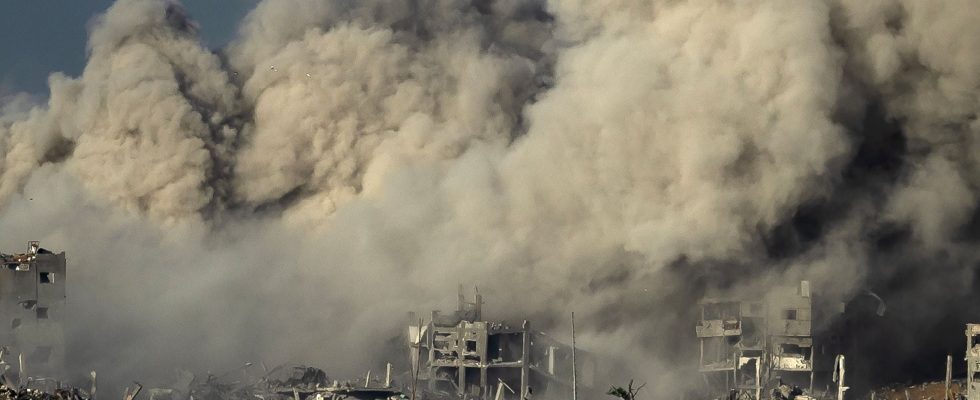Thousands of buildings damaged, broken and, for some, razed. The large-scale destruction is the most visible result of Israel’s operation in the Gaza Strip to “annihilate” Hamas, following the massacre of 1,200 people carried out by the terrorist group on October 7. The UN Office for the Coordination of Humanitarian Affairs estimates that 45% of housing of the territory would have been damaged or destroyed. In the northern area, where Israeli forces are conducting a ground operation, satellite data analysis by the Bellingcat site evaluates, for its partthat between 37 and 49% of buildings suffered apparent damage.
Added to this is a terrible human toll, confirmed by images of injured or dead civilians – the Hamas Ministry of Health mentions more than 15,000 people killed, 70% of whom were women and children. These devastations are indeed a modus operandi for Israel and are the heirs of a military strategy unveiled in 2006. This is sometimes presented as the “Eisenkot” doctrine, named after the general who then led the Israeli armed forces, Gadi Eisenkot – he is now a member of the war cabinet formed on October 11 to manage the Hamas attack –, or the “Dahiya” doctrine, a Shiite neighborhood of Beirut massively bombed during the Israeli-Lebanese conflict of 2006.
“Israeli forces destroyed this entire area to signal to Hezbollah that if it challenges Israel, it will not only be its militants who will be targeted, but all those who support them,” recalls Michael Kobi, researcher at the National Institute of strategic studies, based in Tel Aviv. An American diplomatic cable from 2008, published by Wikileaks, had specified that Eisenkot had “declared that Israel would use disproportionate force on any village that fired on Israel, causing great damage and destruction” and that, for him, “these are not villages civilians, they are military bases. A way, also, to deter any adversary wishing to carry out an attack against the Hebrew State.
In Palestinian territory, this massive use of force is not new. “This is the way Israel has operated for a long time, with the essence of making the other person pay a high price if they attack you,” said Yossi Mekelberg of the London think tank Chatham House, referring to the interventions in Gaza. since 2008. After October 7, this use of force first took the form of a massive bombardment by aviation and artillery. The troops then began their operations on the ground, under air support, with the use of armored vehicles, tanks and bulldozers. Since the end of the truce over the last seven days of November, the Israeli army has announced that it is extending its operations to the south of Gaza, where it is bombing massively – it has indicated that it has carried out “around 10,000 airstrikes” in total since the 7 October – and began a land penetration by its armored vehicles.
An “immoral” strategy
These numerous strikes are not just punitive. They also target military targets for the maximum protection of soldiers deployed on the ground. This “zero risk for our forces […] places the highest priority on the safety of Israeli fighters”, explains in a forum Nadav Weiman, leader of the veterans NGO Let’s break the silence, “then transferring the risk to civilians in Gaza, even if they are not involved in the hostilities”. A strategy that he considers “immoral” in view of its consequences. “A humanitarian catastrophe is unfolding before our eyes,” said UN Secretary General Antonio Guterres. Emmanuel Macron denounced “too many civilian losses”.
Nearly a month and a half after the start of the ground operation, brutal force remains in force, even if some analysts, such as Michael Kobi, assure that the army is showing restraint. “Israeli soldiers fight in Jabaliya and Beit Hanoun [partie nord de Gaza], house by house, at the cost of losses, when the simplest would be to bomb, assures the researcher, previously head of the Palestinian office at the Ministry of Strategic Affairs. But Israel takes international law into account and favors the evacuation of civilians, even if Hamas uses them as human shields, there was no bombing on the Al-Chifa hospital, although it was one of Hamas’ main bases.”
According to the IDF, 75 of its soldiers have been killed in the Gaza Strip since the start of the war. This is probably less than the deaths among Hamas fighters – 5,000 say the army – but at the cost of many deaths among Gazan civilians. “Hamas must be destroyed, there is no doubt about it,” specified in a post the former colonel of the marine troops and historian Michel Goya. But according to him, “we could have hoped, provided we had strong and disciplined soldiers, taking the time and maximum precaution to reach the heart of the enemy, eliminate as many of its fighters as possible and destroy its infrastructure without killing thousands and thousands of civilians. But this approach would have had a price that the Israeli army refuses to pay: a greater number of losses in its ranks.
The pursuit of the Dahiya doctrine, however, risks isolating Israel. “The longer the war, the more damage there is and the more Israel risks losing its Western support, underlines Yossi Mekelberg. We see that the conflict affects societies in France, the United Kingdom and the United States. And then there is a risk that more young Palestinians will fall into the hands of extremists.” An opinion shared by Nadav Weiman, for whom, “the horrible attack of October 7 clearly showed that the defense of Israel requires a different approach.” He added: “The lesson we should learn from past conflicts is that force alone cannot give us Israelis the security we deserve.”
.
